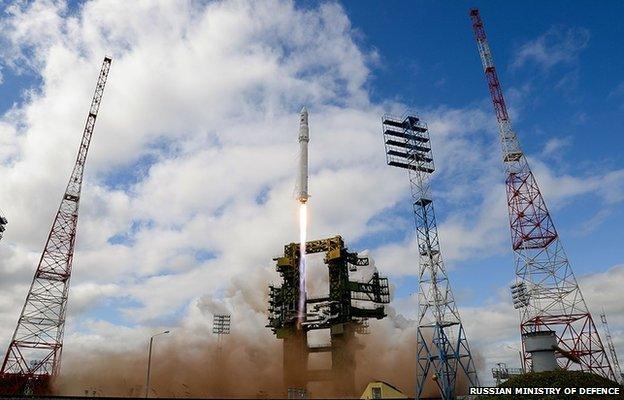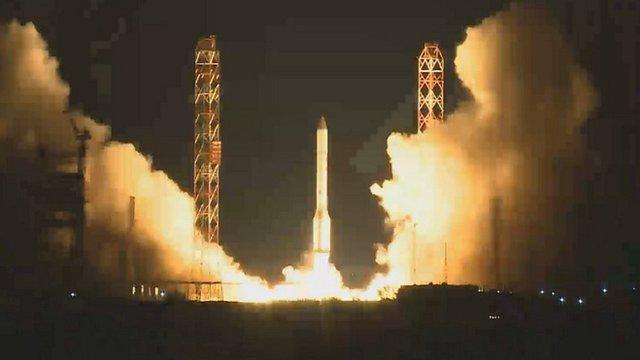Russia's Angara rocket 'makes debut'
- Published

The flight was not intended to reach orbit
Russia has launched its all new Angara rocket on its maiden flight from the northern Plesetsk cosmodrome.
There was no live TV coverage, but later video showed the vehicle leaving the pad at about 12:00 GMT.
The test flight carried a dummy payload and was not intended to reach an orbital altitude.
Angara is designed to give Russia full control over its space activities, reducing its reliance on technologies and facilities of former Soviet states.
These include the rocket components currently sourced from the Ukraine, and use of the famous Baikonur spaceport sited in Kazakhstan.
The maiden flight had been repeatedly delayed. In June, national TV had given the previous attempt extensive live coverage only then to see a technical glitch force yet another postponement.
Reporting of Wednesday's attempt was more muted, therefore.
Confirmation of a successful first flight came through the Russian military news agency Interfax-AVN.

It said that Defence Minister, Army General Sergey Shoygu, had reported the positive outcome to the supreme commander of the Russian Armed Forces, President Vladimir Putin.
And later in the day, it added that parts of the rocket had come back to Earth as expected: "An inseparable dimension and mass mock-up of the payload, together with the second-stage, has fallen in the designated area of the Kura range in Kamchatka peninsula at a distance of 5,700km from the launch site."
Russia's Deputy Prime Minister, Dmitry Rogozin, tweeted that the launch was a "winning start", external.
Replacement plan
Like a number of the world's launchers, Angara is modular in concept, external.
It has a main core that burns kerosene and liquid oxygen. This "universal rocket module" can then be supplemented with additional boosters for extra power, and different designs of upper-stage to place satellites at their correct altitudes.
Wednesday's test version used the simplest configuration - the Angara-1. When this is in service, this will be expected to put up to four tonnes of payload into a low-Earth orbit - the kind of orbit used by Earth-imaging satellites.
Other variants are planned, including a heavy-lift version designated Angara-5.
This should be capable of putting up to 7.5 tonnes into the geostationary transfer orbits used by telecommunications spacecraft as they make their way up to 36,000km above the equator.
Russia wants to launch the Angara family both from Plesetsk and the Vostochny Cosmodrome, which is currently being constructed in the Amur Oblast, in the Russian far east.
The new rockets would allow the country to phase out a suite of older vehicles, including the heavy-lift Proton launcher. This has had a torrid reliability record of late.
The immediate plans are to use the Angara family for unmanned launches only, but manufacturer Khrunichev, external is developing a human-rated Angara-5 for launch from the Vostochny Cosmodrome.
Russia currently operates Soyuz rockets for manned flights from Baikonur.

Jonathan.Amos-INTERNET@bbc.co.uk and follow me on Twitter: @BBCAmos, external
- Published5 July 2014
- Published16 May 2014

- Published14 May 2014
- Published25 April 2014
- Published20 June 2013